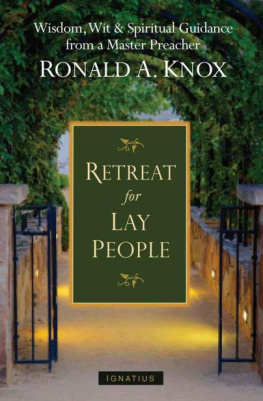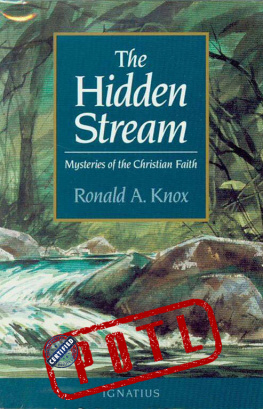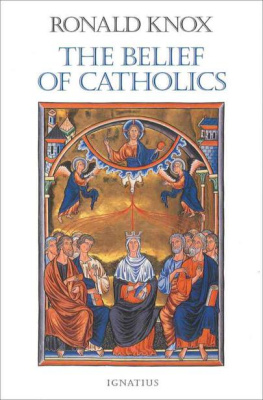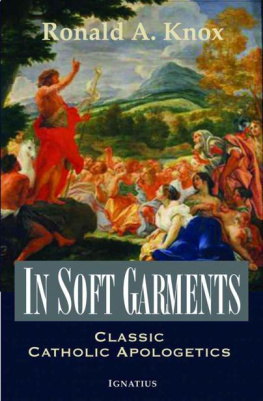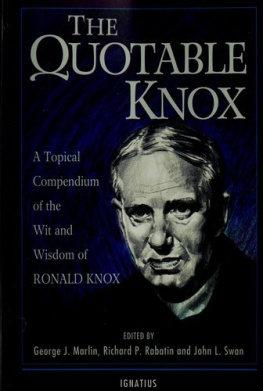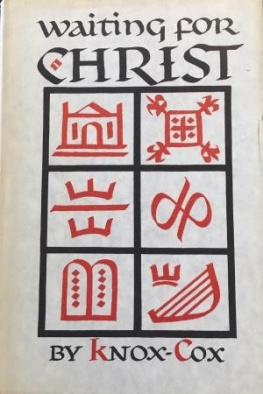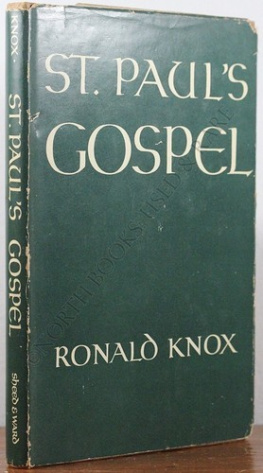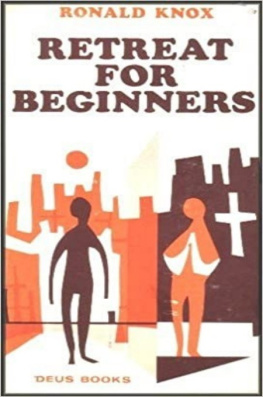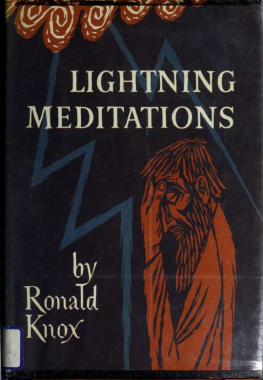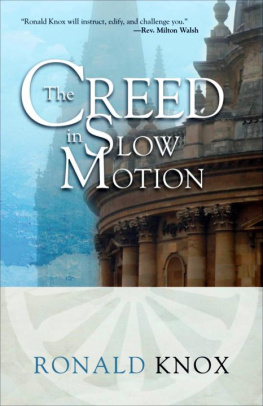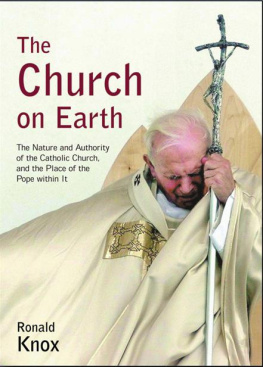A RETREAT FOR LAY PEOPLE
A Retreat For
Lay People
Spiritual Guidance for
Christian Living
RONALD KNOX
IGNATIUS PRESS SAN FRANCISCO
Original edition 1955 by Sheed and Ward, New York
Nihil obstat : Hubertus Richards, S.T.L., L.S.S., Censor Deputatus
Imprimatur : E. Morrogh Bernard, Vic. Gen . Westmonasterii, die 4A Decembris, 1954
Cover photo by Mars Lasar/iStockphoto.com
Cover design by Riz Boncan Marsella
Published in 2011 by Ignatius Press, San Francisco
Copyright by the Earl of Oxford and Asquith
All rights reserved
ISBN 978-1-58617-592-4
Library of Congress Control Number 2010937200
Printed in the United States of America
TO MAGDALEN ELDON
CONTENTS
VIII. The Love of God
Holy HourA Hidden God
XVI. The Entombment
Holy HourThe Mass and the Life of Christ
PREFACE
There are, I suppose, two ways of conducting a retreat, I mean, of preparing those meditations which are the bones of a retreat. One is to take a single idea which will run like a thread through all the meditations and bind them together, make them into a coherent whole. The other is to seize upon an idea here, an idea there, as they occur to you in the intervals of prayer or in the course of reading, work it out there and then, and lay it by for future use. This means that you have a stockpot of meditations from which you can select the items which seem most appropriate to the occasion; but the framework of your retreat will be of the flimsiest.
The Retreat for Priests, which I published eight years ago, was of the former kindwas, as you may say, a strategic retreat. It followed the course of Old Testament history, finding types everywhere to illustrate, and in some sort of order, the familiar themes of Christian piety. The present volume makes no such claim to organic unity. I have simply put together certain samples of the meditations I have been giving, these fifteen years back; they are not of a pattern. But I doubt whether there is any need to apologize for this cavalier procedure. When you are in retreat, it is always difficult to find the book you want; there is a daintiness in your spiritual tastes which calls for the meal a la carte, rather than the table dhote. All the better, then, if you light on a work which leaves you free to pick and choose, instead of following the whim of your author. There is room for books which offer a varied menu to the retreatant.
Some of these meditations were designed partly, though not exclusively, for school-boy audiences, and are simpler than the rest. Some were written during the war years, when the repercussion of public events was felt more deeply than it is at present. In any case, they represent a series of moods, not a single, fixed mood, on the part of the author; and this allows him to hope that one here, one there will chime in with the mood of the reader.
At the same time, they have not been thrown together at haphazard; they are so arranged as to fit in, more or less, with the traditional lines laid down in the Spiritual Exercises . They fall into three groups of eight; of these, the first represents the foundations; the second is based on the life and death of our Blessed Lord; the third envisages practical, day-to-day needs. Between the first group and the second, and again between the second group and the third, I have thrown out suggestions which might be useful to those who are following the devotion of the Holy Hour.
To those who have asked, at Grayshott and elsewhere, whether I meant to publish my retreat, I have fulfilled a promise.
MELLS, Feast of Saint Ignatius, 1954
I
DISCOURAGEMENT IN RETREAT
The Gospels tell us curiously little about the machinery of our Lords life on earthI mean, about the houses he actually lived in, the rooms he actually took his meals in, when he was not taking his meals or passing the night on the open mountainside. Again and again we are told that he was in the housewhat house? His own, or somebody elses? And if so, whose? True, at the beginning of Saint John, two disciples want to go and see where he dwells; he invites them there, and they spend all the day with him, but never a word about this dwelling-place of his; Saint John doesnt tell us what it was like when they got there. Once, and once only, we are let into the secret of our Lords arrangements, and the description we are given makes them more mysterious than ever. It is on the eve of his Passion: He sent two of his disciples [we are told] on an errand: Go into the city, and there a man will meet you, carrying a jar of water; you are to follow him, and say to the owner of the house into which he enters, The Master says, Where is my room, in which I am to eat the paschal meal with my disciples? And he will show you a large upper room, furnished and prepared; it is there that you are to make ready for us. Some forty days later, after the Ascension, we are told that the disciples went up into the upper room, where they dwelt, all eleven of them; all these, with one mind, gave themselves up to prayer, together with Mary the mother of Jesus, and the rest of the women, and his brethren. It is natural, I think, to suppose that the same upper room is meantthe whole upper floor of some fairly large house, which our Lords followers used as their place of assembly, and probably as their living quarters, whenever they found themselves in Jerusalem between the Last Supper and the Day of Pentecost.
If so, what memories it must have had for them! A haunted room, that had witnessed so much of a brief but poignant history! You may call it, if you will, a drama in five acts. The first act was the Last Supper itself. There, on that table, they had rested the plate of bread, the cup of wine, over which the words of mystery had been uttered. Through that door, pursued by questioning glances, the traitor had slunk out into the night. Those walls still echoed with the accents of the remembered voice: After a little while, you will see me no longer, and again after a little while you will have sight of me, because I am going back to the Father. Memories of foreboding and bewilderment, of dark suspicions, and of high resolve.
Of the second act, the Gospels tell us nothing; the omission is not difficult to account for. But I suppose the disciples, when they fled from Gethsemani, will have found their way, little hunted parties of them, back to the Cenacle. Where else should they go, in Jerusalem? Whom should they trust, now that one of their own number had turned renegade? In little groups, avoiding one anothers eyes, they crept back to their old rendezvousthe men who had boasted, a few hours back, that they were ready to die with their Master. Only one is missing; what has become of Simon Peter? Was he, after all, as good as his word? And then the door opens once again, and the tale of their defection is complete; Simon Peter has come in, his face furrowed with tearsmemories of shame and of defeat, of a time when all was lost, and their honour was lost too.
Easter morning had come and gone, but the same imaginary fears persisted. They are still behind locked doors at the opening of the third act, on the Sunday evening. But their fears are mingled with a strange excitement; the body of their Master no longer rests in its grave, and stories are being told of lonely encounters with him, in the pale light of dawn, the fading light of dusk; are they, after all, to see him again? If so, it will not be here; his own message is clear about that: He is going on before you into Galilee , where you shall have sight of him. Not here, in the theatre of their defeat, among the memories of their shame, but on the hill-slopes of Galilee, restored to the innocence of their first conversion, they will be able to meet him and look him in the face. All at once, they are conscious of a newcomer in their midst, one for whom locked gates without, locked doors within, are no barrierit must be a spirit! But no, it is their Master himself; there are scars on hands and feet; in matter-of-fact tones, he asks them if they have any food handy; he eats and drinks before them. Memories of excitement and alarm, of relief and sudden rejoicing.
Next page
